INTRODUCTION
Allocation of resources in most crime laboratories is a constant struggle. Ever-present backlogs, partly due to an increase in the use of forensic deoxyribonucleic acid (DNA) testing amongst law enforcement investigators, cause regular evaluations of the best uses of the limited resources available.2,3 The classic model of allocation of resources in the modern forensic DNA laboratory is to provide for the investigation of all homicide and sexual assault cases and then for as many lesser crime cases, such as robberies and burglaries, as possible.4 For simplicity, these lesser crimes will be referred to as property crimes throughout the study. As the number of property crime cases usually exceeds the number that the crime laboratory can process, an effective method of prioritizing cases would be of significant value.5 This study attempts to measure the value of testing different types of evidence commonly found during property crime investigations. Common items collected at property crime scenes include bloodstains, drinking containers, cigarette butts, clothing, rocks, and various types of tools. There is limited data currently available in the literature specifically focusing on property crimes to determine which type of evidence yields the best results in terms of obtaining usable DNA samples, identifying potential suspects, and leading to arrests.
MATERIALS AND METHODS
All of San Diego Police Department’s DNA cases from the year 2010 were reviewed. Cases from which data was collected focused specifically on suspect-less property crimes with single evidence items. Crime and evidence type were documented for each case, and whether each item resulted in usable DNA results, a mixture of DNA profiles, a cold hit in the Combined DNA Index System database (CODIS), and an arrest of the subject of the cold hit. Focusing on single-item cases was done to remove as many variables as possible, as it was more difficult to judge the value of an individual evidence item when multiple items were tested. While useable results, mixtures of DNA profiles, and cold hits were easy to assess from the available laboratory reports, accurate arrest data was dependent on the appropriate recording of information by officers in the San Diego Police Department records system.
RESULTS
Of the 430 total assessed cases, 330 involved evidence items that were included in the study criteria (Table 1). The remaining 100 cases consisted of a variety of additional evidence items (e.g., steering wheels, cell phones, hair samples) which were not included in the study analysis due to small sample size.
| Table 1: Data Summary. |
| Data Summary by Tier and Evidence Type |
| Tier |
Types of Evidence |
No. of Samples |
No. of Usable Results |
No. of Mixed Profiles |
No. of Cold Hits |
No. of Arrests |
| 1 |
Bloodstains |
63 |
61 (97%) |
1 (1.6%) |
46 (73%) |
32 (51%) |
| Tier 1 Totals |
63 |
61 (97%) |
1 (1.6%) |
46 (73%) |
32 (51%) |
| 2 |
Drinking
Containers |
36 |
30 (83%) |
9 (25%) |
20 (56%) |
8 (22%) |
| Cigarette Butts |
25 |
20 (80%) |
5 (20%) |
9 (36%) |
4 (16%) |
| Tier 2 Totals |
61 |
50 (82%) |
14 (23%) |
29 (48%) |
12 (20%) |
| 3 |
Clothing |
82 |
65 (79%) |
53 (65%) |
50 (61%) |
24 (29%) |
| Rocks |
35 |
16 (46%) |
18 (51%) |
10 (29%) |
5 (14%) |
| Tools |
89 |
38 (43%) |
44 (50%) |
23 (26%) |
10 (11%) |
| Tier 3 Totals |
206 |
119 (58%) |
115 (56%) |
83 (40%) |
39 (19%) |
Of all the items included in the analysis, bloodstains (n=63) gave the highest incidence of usable results (97%) (Figure 1), cold hits (73%) (Figure 2), and arrests (51%) (Figure 3), while having the lowest number of mixed profiles (1.6%) (Figure 4). These findings are in agreement with previous studies which concluded that blood evidence yields more successful DNA results than any other biological evidence or items that have been handled or touched.6 Tools (n=89), on the other hand, were the most numerous type of evidence tested, yet gave the lowest arrest rate (11%) (Figure 3).
Figure 1: Incidence of Usable Results by Evidence Type.
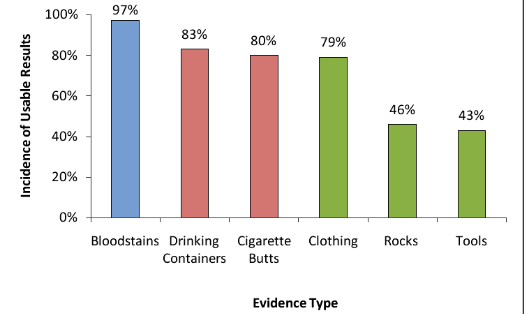
Figure 2: Incidence of Cold Hits by Evidence Type.
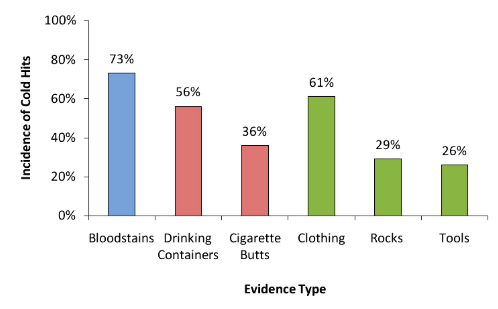
Figure 3: Incidence of Arrests by Evidence Type.
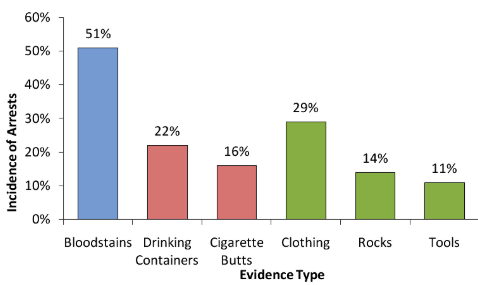
Figure 4: Incidence of Mixed Profiles by Evidence Type.
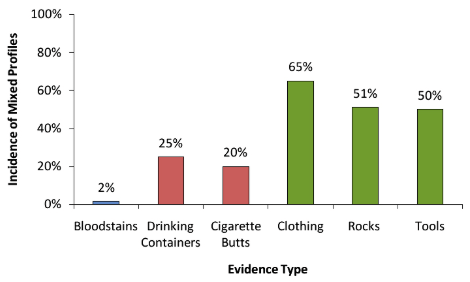
DISCUSSION
Every case is different, and there are many factors that determine the value of a DNA cold hit in a given case. One factor that is of particular interest to the laboratory is the type of evidence from which the DNA was collected. While there are other important factors, evidence type is one of the easiest factors by which laboratory managers can base some of their decisions.
Although there is also a large variation in the types of evidence that can be submitted to the laboratory for DNA testing, the bulk of the items tested fall into a handful of types, which can be further grouped into three main categories, or tiers. We have proposed a three-tier model that will be used as a conceptual tool for categorizing and prioritizing evidence. These tiers consist of evidence that tends to link someone to a crime (Tier 1), evidence that tends to link someone to a crime scene (Tier 2), and evidence that tends to link someone to an item (Tier 3) (Figure 5).
Figure 5: Proposed 3-Tier Model.
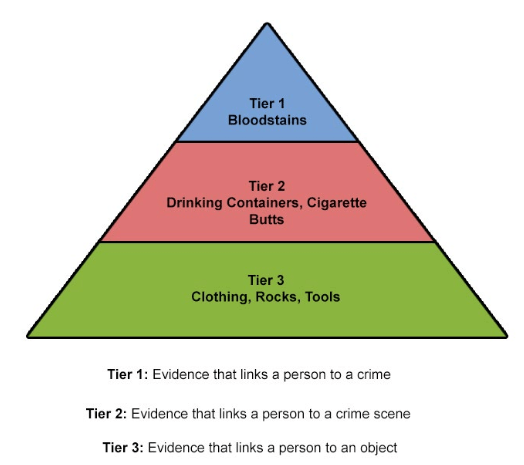
These descriptions are simplifications; alternate explanations for the presence of someone’s DNA on an item or at a crime scene are limited only by one’s imagination. To facilitate a reasonable discussion, it will be assumed that evidence was not planted at the crime scene nor the result of contamination, and that items such as a cigarette butts are not normally moved after being used and discarded. In court, the implication of finding someone’s DNA at a crime scene or on an item is often a major source of contention. Does the presence of someone’s DNA on an item truly link them to the crime, or is there an innocent explanation for the presence of their DNA on an item or at a crime scene? The generalizations made in this discussion do not take away from the natural debate or disagreement that can occur on this matter.
DNA testing of evidence from homicide and sexual assault cases is typically given the highest priority, and often easily fits within the laboratories’ resources.4 Generally, forensic laboratories process all requested homicide and sexual assault evidence, and as much property crime evidence as they can. The testing of DNA evidence from these high volume property crimes often causes laboratory management to find itself with more potential work than can be completed, and thus will have the need to make informed decisions concerning the optimum utilization of resources. As such, the following discussion will focus primarily on evidence that is most often tested in property crime investigations.
Tier 1 evidence is that which tends to link someone to an actual crime and is naturally the most valuable evidence to examine during a criminal investigation. This type of evidence however, usually makes up a fairly small portion of the DNA testing that is performed in the crime laboratory. At property crime scenes, the most common situation of finding Tier 1 evidence is when a bloodstain is left at a burglary scene where a window was broken.4 A bloodstain from a burglary is very likely to be from the perpetrator and will presumably yield a large amount of DNA from a single person. Evidence of this type is sometimes referred to as prima facie evidence, in that the evidence that links the person to a crime is so strong that it becomes the burden of the person considered as the source of the DNA to provide a non-criminal reason for the presence of their DNA at the crime scene.
Tier 2 evidence is that which tends to link someone to a location. While this evidence may link a person directly to a crime scene, it does not necessarily link that person to the crime. Common examples of this type of Tier 2 evidence are cigarette butts and drinking containers. These types of items are generally used once, discarded after use, and in most cases not immediately moved from where they were discarded. Biological samples found on cigarette butts and drinking containers are usually saliva, which is a strong source of DNA. Because these items are typically only used by one or two people, they tend to provide robust single-source results or simple mixtures.
Tier 3 evidence is that which tends to link a person to an item. This item may have been found at a crime scene, but it does not necessarily mean that the person was ever at that location. It simply means that the person likely made contact with that item at some point in time. Common examples of this type of evidence are clothing and tools. Based on their nature, these items can prove to be more challenging to analyze than Tier 1 and 2 items. Clothing and tools are items that are designed to be used repeatedly over a long period of time. They are often used by multiple people, which can lead to complex mixtures of varying levels of DNA.
Tier 2 and 3 evidence does not prove guilt; this type of evidence merely provides an investigative lead. It is logical to believe that sometimes people who are the subject of a DNA cold hit to this type of evidence are not the perpetrator of the crime being investigated. An investigator typically would compare information about the subject of the cold hit to any available information about the perpetrator of the crime. In the event that a detective continues to suspect a person’s potential involvement in a crime, further investigation may lead to the discovery of additional evidence implicating the person. Common examples of corroborating evidence include witness identification, video recordings, and the finding of stolen property. Linking a person to less than ideal evidence found at numerous crime scenes can also be an effective method to implicate a person in a series of crimes.
The descriptions of the various types of evidence and their relative values can help explain why the arrest rate for cold hits to bloodstains found at property crime scenes is over twice that of other types of evidence (Figure 3). These descriptions and the observed arrest rates (Figure 6) support giving Tier 1 evidence higher priority than Tier 2 or 3 evidence by a crime laboratory or law enforcement agency experiencing a limitation of resources.
CONCLUSION
The primary goal of this study was to determine which types of DNA evidence from property crimes would most likely lead to arrests. The arrest rate for cases with blood evidence were approximately 250% greater than for those with non-blood evidence (Figure 6). These results suggest that evidence that tends to link a person to a crime (Tier 1), such as a bloodstain left at a burglary scene, should be given the highest priority in criminal investigations. Although, it could be argued that evidence that links a person to a location (Tier 2) would be more valuable than evidence that merely links a person to an item (Tier 3), both categories of evidence resulted in nearly identical rates of arrest (Figure 6). While individual evidence types gave differing arrest rates, the limited amount of data present suggests treating this information with an appropriate amount of caution. Our findings suggest that while bloodstains from property crimes should be given the highest priority, further prioritization based on evidence type is not definitively supported by the results of this study. Considering other factors such as the intensity of violence and the severity of the crime could potentially be more effective in maximizing the public safety impact of testing DNA evidence.
Figure 6: Incidence of Arrests by Tier.
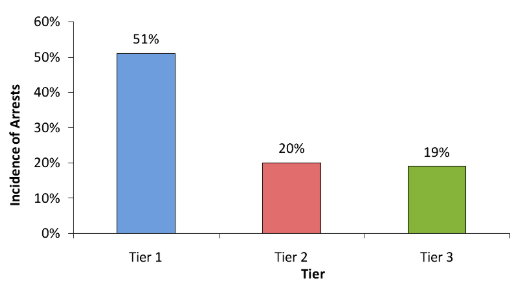
CONFLICTS OF INTEREST
The authors declare that they have no conflicts of interest.











